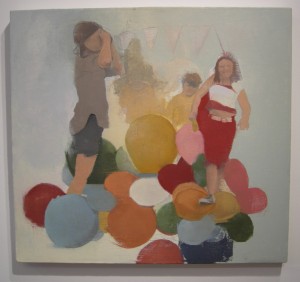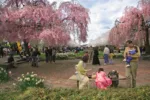It’s no surprise that good artists know other good artists; curators and gallerists always turn to artists for recommendations. Nor is it surprising that artists fill the ranks of museum art handlers. Art handlers are almost exclusively artists, as are many behind the scenes museum workers; all but curators, for some reason. What is a surprise is how strong and varied the exhibition is that Hiro Sakaguchi organized of work by thirteen of his colleagues at the Philadelphia Museum of Art ( PMA), showing at Cerulean Arts through June 18. It’s a good indication of how pluralistic the current art world is. I hope their museum colleagues from other departments visit and are suitably impressed.
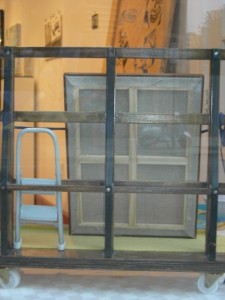
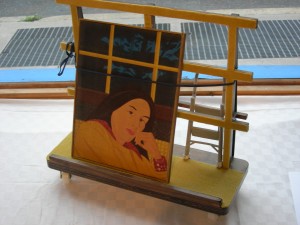
The miniature construction which sits in the gallery’s window, a cart for moving paintings holding one of the museum’s Alex Katzes, is perfect in every detail, down to the folded step ladder on the cart (except that I expect the verso of a museum’s painting would have a backing-board; but showing the stretcher bars is much more interesting). It was made by Nick Balko, James Coyne, Sam Faix, Eric Griffin, Chris Havlish, Sebastien Leclercq, Beth Paolini, Joe Proiani and Hiro Sakaguchi.
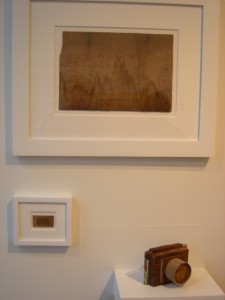
Patrick OLoughlin’s three-part, low-tech riff on both photography and Chinese ink-painting is delightful: a 3-d model of a camera, a framed “negative” and the larger framed “photograph” – all made of what looks like balsa wood. OLoughlin used the stains on the found wood as the image, which resembles ink painting to a remarkable degree. I wonder whether he saw the exhibition of Miroslav Tichý’s work shown recently at the International Center of Photography which included Tichý’s purposely crude but functional cameras made from cardboard, match boxes, wire, and other found materials which he used to avoid the attention of the authorities as he snapped photos of the young women of Kjvov (Czechoslovakia).
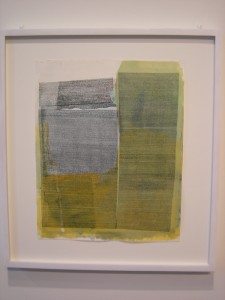
The lyrical-obsessive ink drawing on collaged paper by Chris Havlish works as an abstract collage at a distance, it’s vertical division resembling the columns of a printed page. At close viewing his tiny circles, which would surely hold fewer dancing angels than would the head of a pin, create magical patterns, removed from being mechanical by their obviously hand-rendered individuality.
Justin Webb‘s digitally-conscious figuration is painted with a very sure color sense. Something about the juxtaposition of areas of color and the restraint with details brings to mind the work of Fairfield Porter.
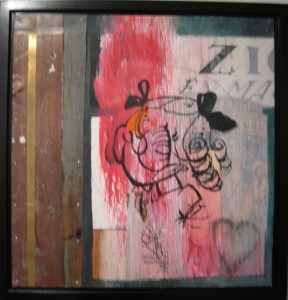
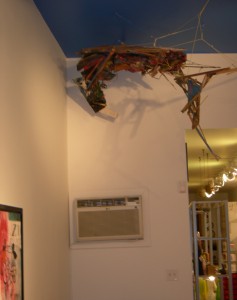
James Strauss works in an international graffiti mode while Austin Heitzman‘s assemblage, hung high in one corner of the gallery, is both current with recent tendencies in sculpture made of re-purposed materials and reminiscent of 1960’s assemblage, whether Rauschenberg combines or Bay Area Funk.
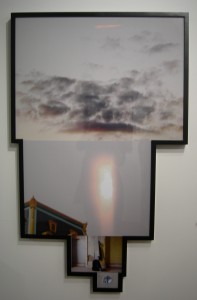
I wasn’t certain whether the flash of light in Sebastien Leclercq’s multi-image photographic piece was a reference to the supernatural; the artist said he was concerned with time. I particularly liked the fractured point of view of the multiple images. The grid of Sam Faix‘s multi-layered painting might represent a map of the city of the painting’s title, but the sensual paintwork with evidence of liquid and translucent paint is sufficiently interesting that it needn’t have a referent.
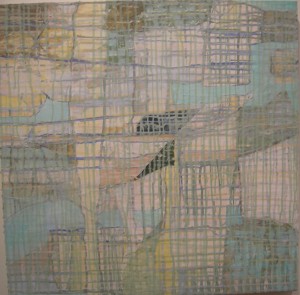
In reference to Libby’s recent discussion about purchasing art, I might mention that the work in this exhibition is extremely well-priced from the collector’s point of view. If my pockets had been full I’d have bought several pieces, and if someone else doesn’t grab them it’s a shame.
Sakaguchi has curated another exhibition, I Can’t Get You Out of My Mind, which opens Friday, May 21 at Seraphim Gallery and runs through June 22. If history means anything, it will be worth seeing.


